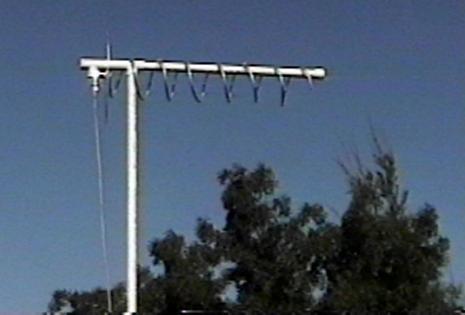
OCAR Antennas

The above picture is of a simple 8 turn helix made from aluminum gas tubing.
Particularly at UHF and low microwave, helixes are interesting for higher
speed, wideband communications and on-channel repeaters for several reasons:
At shorter wavelengths, a slotted waveguide antenna may be a good choice
for an OCAR. Stephen Bell, KB7TRZ presented this
Slot
Antenna Design at the 40th Annual West Coast VHF/UHF conference .

This data is taken only every ~10 degrees over a half-rotation but shows the good correlation in the forward direction of the measured radiation pattern (red) of the short helix pictured above compared to the theoretical pattern (blue) from W8JK's text. Major circles are every 10 dB. Forward gain (0 degrees and 0 dB on the plot) has been measured at ~13 dBi (circular). As can be seen from the plot, the side-rejection is reasonable, in the vicinity of 25 dB.
As mentioned above, with the transmit antenna located near the first null of the receive antenna and a little additional isolation due to foliage absorption, we are achieving about 85 dB antenna-to-antenna isolation. Because overall performance of an OCAR is so dependent on amplifier gain, and amplifier gain is bounded by antenna isolation, it is worthwhile to use additional tricks to maximize it.
Here is some additional information about the Gain of Helix by Dr. D.T. Emerson, National Radio Astronomy Observatory and published by the ARRL about helical antenna gain and gain as a function of boom length and turn radius.
Here is an animation showing the pattern and gain of a helix as a function of the number of turns. The pattern is generated using the equations from W8JK while the gain is from the NRAO data above.
Here are plots of three experimental helixes, just for fun. It includes a 7 turn, an 8 turn and a dual 7 turn helix with the two individual antennas pointing about 30 degrees from normal boresite. The dual could actually be useful in tailoring a pattern for two different coverage areas.